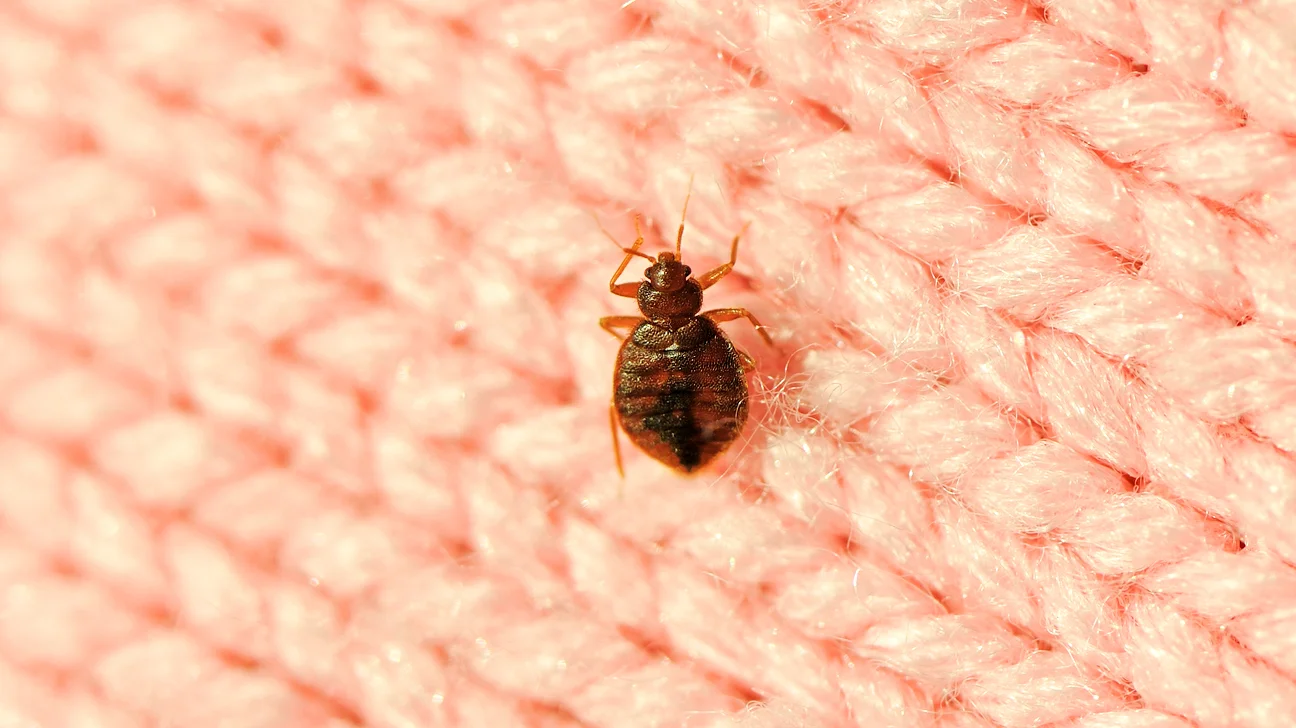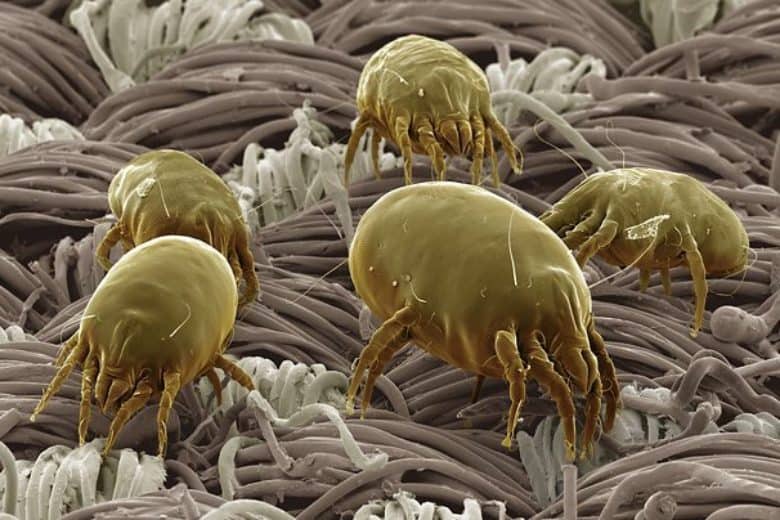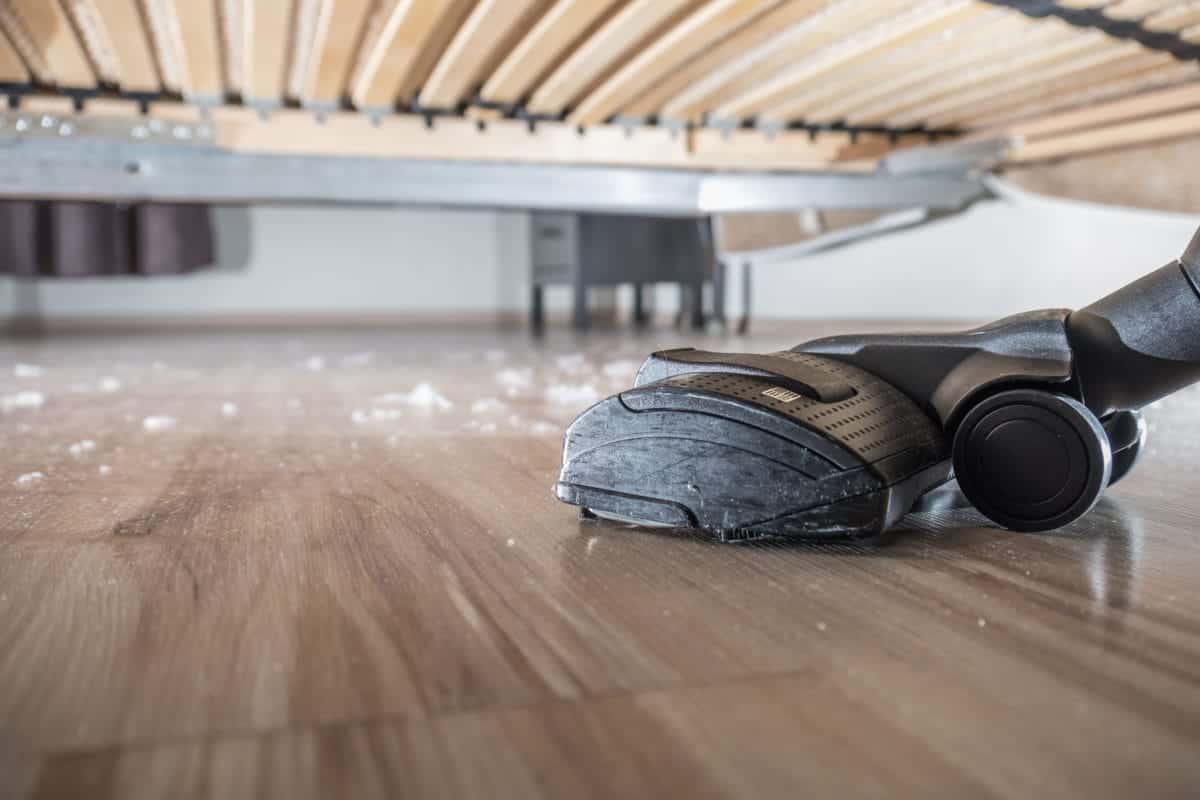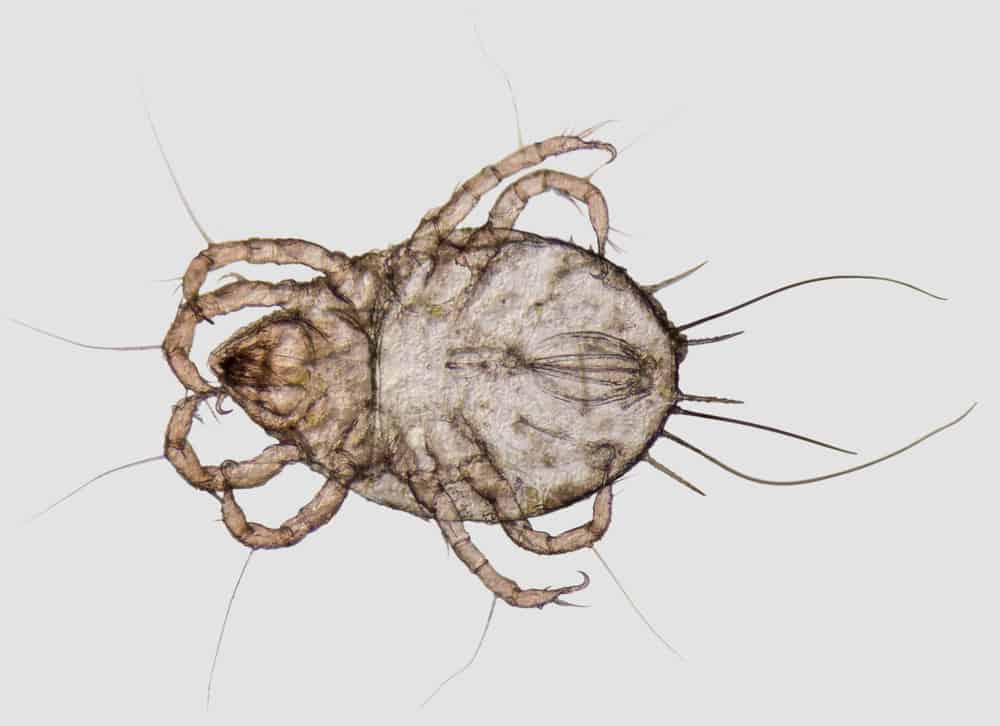Dust mites lurk around in your home seemingly unnoticed since you can not see them with the naked eye. These creatures are known to cause serious allergies, and sufferers are all too familiar with the agonizing symptoms that dust mites cause.
But what do dust mites eat? In this article, we will talk a little bit more about what dust mites are and what they eat. The answer may surprise you!
What Are Dust Mites?
House dust mites are tiny, microscopic creatures that are usually found in dusty areas in homes and businesses. Places like mattresses, upholstered furniture, carpets, and fabrics such as curtains are also common places for dust mites to hide.
These mites are also a common household allergen, and roughly 30 percent of the population has a dust mite allergy. Exposure to dust mites could cause a plethora of unpleasant symptoms. Dust mite allergy symptoms include itchy, watery eyes, itchy nose, runny nose, sneezing, scratchy throat, coughing, and even asthma.
The insect-like tiny creatures only live for around 100 days. However, they can lay up to 80 eggs and poop around 200 times in their lifetime! That is a lot of reproducing and pooping in such a short amount of time!
It only takes around six days for mite eggs to hatch, which releases the larvae. In 3 weeks, a dust mite becomes fully mature and ready to start reproducing itself.
Because they lay so many eggs and quickly reproduce, keeping them under control is very important, especially if you are sensitive to dust mite allergens.
What Do Dust Mites Eat

Image Credit: Healthline
Since these critters stay so busy laying eggs and pooping in their life, their nutrients are vital to sustaining them, like all living creatures. But what do they eat? A lot, actually! Here is a list of the most common dust mite foods.
1. Skin Cells
Human skin cells and pet dander are the two biggest substances dust mites consume. Dead skin cells fall off in scales and contain certain types of bacteria and fungi that these creatures thrive off of.
Dust is made up of many different substances, including small fragments of dead skin cells and pet dander, which is why dust mites are most prominent in the dust. The dust serves as a buffet for the little critters.
2. Synthetic Material
Synthetic materials are also a favorite food for these troublesome insects. This may be the reason your allergies get worse when sleeping on your pillow.
A lot of pillows are made up of synthetic materials, which are not only a food source for dust mites but also a nesting spot due to the warmth of the material.
3. Skins Of Other Dust Mites

Image Credit: Pure Clean Carpet Cleaning
Yes, dust mites eat cast-offs from other dust mites. Dust mites shed their skin, called cast-offs) at a certain point in their life cycle, and when they do, other dust mites jump at the opportunity to have a delicious, nourishing meal of dead dust mite skin.
4. Pollen
Pollen is also found in dust particles, which makes it another main food source for dust mites. Pollen is a microorganism released by male plants which are needed to fertilize female ovules so they can produce seeds.
It is carried from plants and flowers through insects such as bees. When the bee that is carrying the pollen lands on a female ovule, it is fertilized.
However, we can also track pollen inside through our shoes and other items that are outside when we bring them inside. Once it is inside, it collects dust particles for dust mites to feast on.
5. Mold
Mold is another favorite food for dust mites, and if you have mold in your home for the mites to feast on, you have bigger problems than just dust mites.
If you suspect you have molded areas of your home, you need to call a professional to assess the problem. While mold is a delicious treat for dust mites, it is dangerous to human health.
6. Their Feces
Lastly, dust mites also eat not only their own feces but also the feces of other dust mites. This is due to the fact that dust mite feces contain remnants of the bacteria, fungi, and organisms found in the particles they consume.
How To Get Rid of Dust Mites
Now that you know what dust mites eat, let’s talk about what you can do to get rid of these insects and prevent them from wreaking havoc on your body and causing awful allergies.
You can take nasal decongestants, allergy medications such as antihistamines and nasal corticosteroids, or even prescription strength medications or allergy shots to lessen your allergy symptoms until you have minimized the dust mite population in your home.
1. Use A Dehumidifier
Dust mites thrive in humid environments, so using a dehumidifier in your home will work wonders. Dehumidifiers work by drying out the air in your home, creating humidity levels that dust mites dislike.
The dehumidifier will also help relieve some of your allergy symptoms.
2. Replace Your Air Filter
It is highly recommended to replace your air filter at least once every three months! Air filters help filter the air that is circulated through your home to eliminate particles such as dust, which also helps eliminate dust mites.
After a while, your air filter becomes dirt from all of the build-ups and won’t circulate air properly. This means those nasty particles are not being filtered out and are recirculating through your house.
You can also try using a HEPA filter which will further filter out allergens, such as dust mites.
3. Dust Your Home Regularly

Image Credit: FamilyDoctor
This is the most obvious way to keep dust mites at bay. Make sure you are dusting your home on a regular basis to get rid of dust mites and prevent infestations.
Remember to dust above your ceiling fans and hard-to-reach places, as dust accumulates most in these areas.
4. Keep Your Floors Clean
Floors are another big food source for dust mites because everything accumulates on your floors and lands in corners and crevices. To prevent this from happening, it is important to sweep or vacuum your floors every day and mop them at least once a week.
If you don’t have time to clean your house like you should, consider hiring someone to clean your home once a week.
5. Switch Your Bedding
If you are suffering from allergies, it is probably time to change some or all of your bedding. Start by seeing what your comforter and pillows are made out of. If they contain synthetic materials, you may want to replace them with ones that are organic.
This is also true if your bedding has been sitting in a chest or drawer for a long time. It is possible it has accumulated dust mites within the material. If you don’t want to replace it, try washing it in hot water.
Old mattresses are another thing to consider when it comes to getting rid of dust mites. Consider getting a new mattress, or at least taking a handheld vacuum cleaner to the one you have to see if this helps your allergy symptoms.
Conclusion
Dust mites make a meal out of many things found in common households. The best way to prevent a dust mite infestation is to keep your home dust free and create an unhospitable environment for the microscopic critters.
Keeping your house clean is the best way to eliminate dust mites and prevent them from reinfesting your home.
We hope you found this article helpful. Let us know in the comment section below if you have any questions or concerns. We love to hear from our readers!
